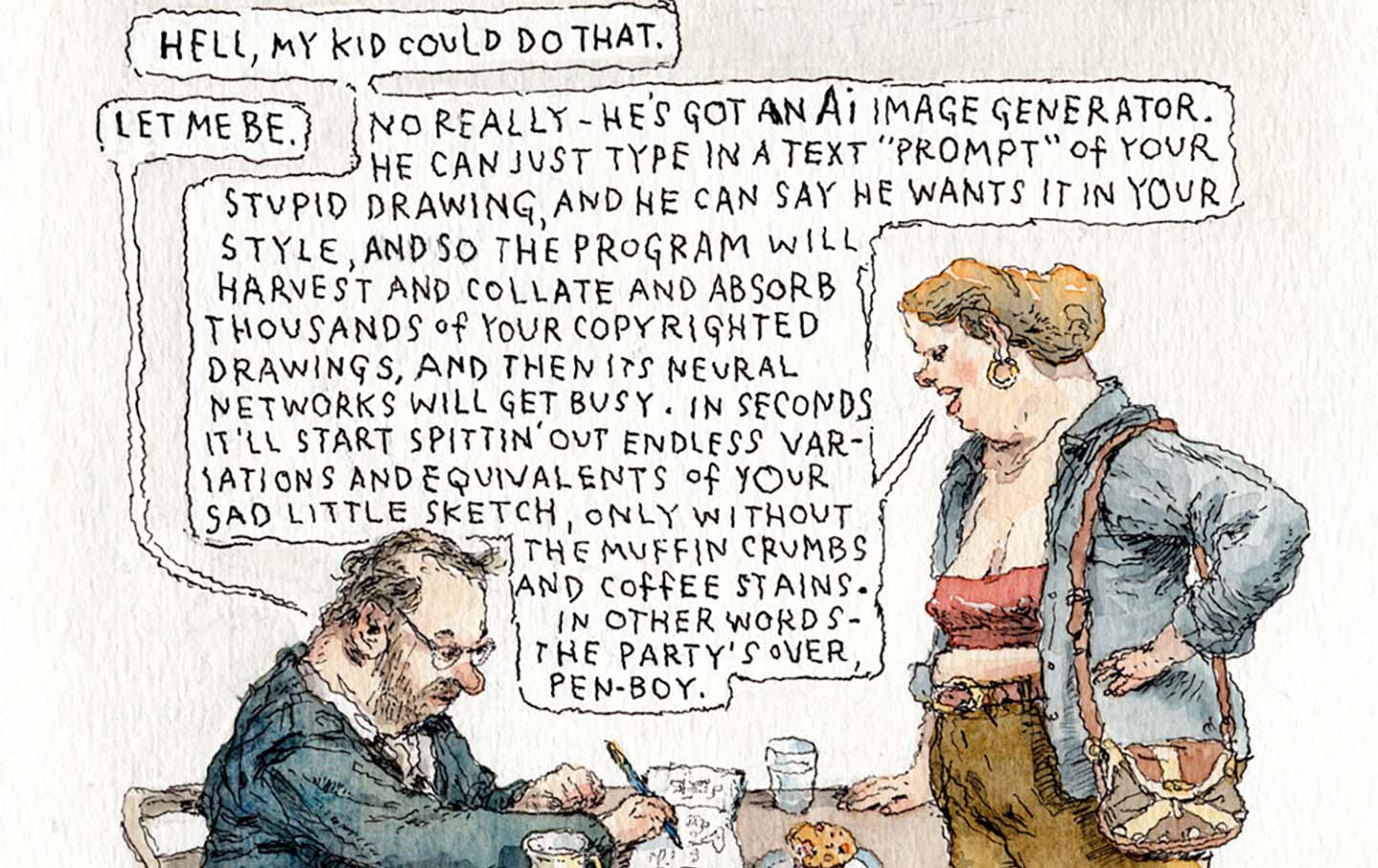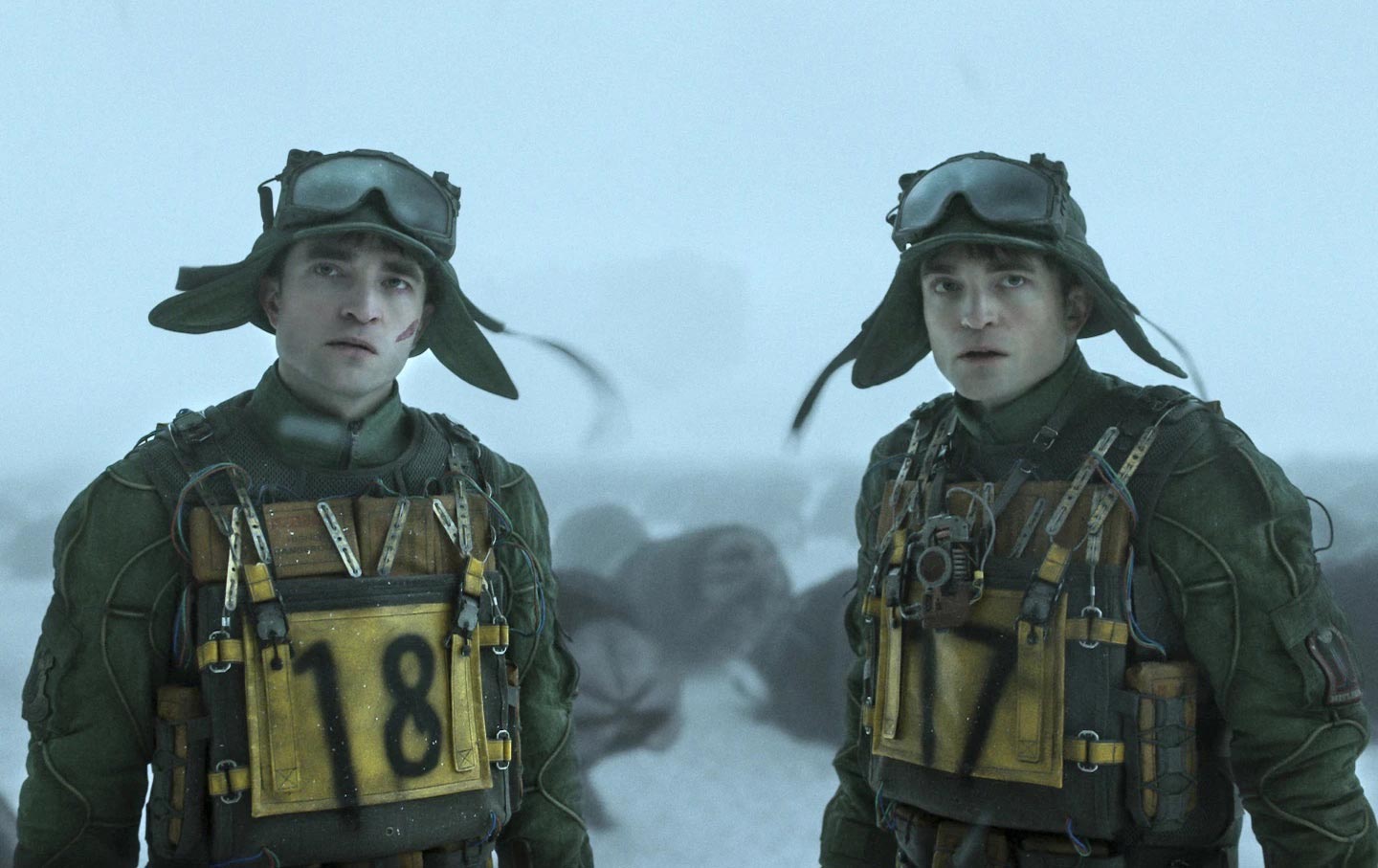25 Years of Indecision With Jon Stewart
Before he left his post at The Daily Show, Stewart was America’s voice of reason. Times have changed. Has he?
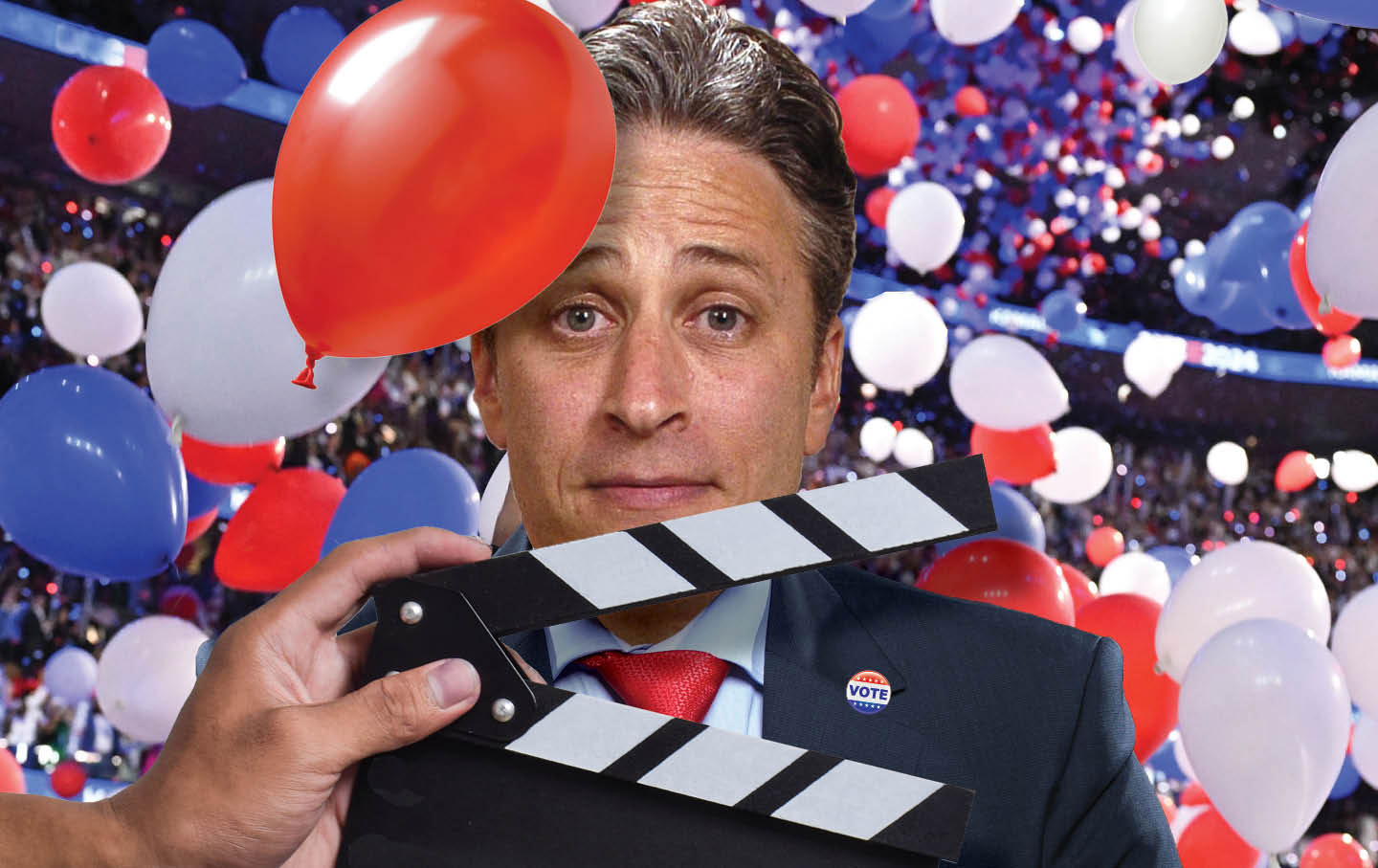
“Men make their own history, but they do not make it as they please.”
—Karl Marx, The Eighteenth Brumaire of Louis Bonaparte, 1852
“Put down the bong. We’re living through history.”
—Jon Stewart, The Daily Show promo, 2000
November 7, 2000, prime time, and everything at The Daily Show’s studio on West 54th Street in New York City was rolling along on schedule. The program’s producers and stars were in a celebratory mood. That night’s broadcast would cap months of successful election coverage, dubbed “Indecision 2000.” These spots saw the cast of Comedy Central’s nightly satirical news show mingling among legitimate press and accredited media, trailing both the Democratic hopeful, Vice President Al Gore, and his challenger, the Texas political scion George W. Bush. As polling stations began closing down across the country, the Daily Show staff retreated to a nearby nightclub for a party being thrown by the network’s bigwigs.
It was Comedy Central’s way of toasting the show’s success and rewarding the team for its own grueling work on the campaign trail. “We’ll just knock out the election special, then we’ll go to the party, and ‘Indecision 2000’ will be behind us,” recalls Madeleine Smithberg, The Daily Show’s cocreator and executive producer. “What we didn’t know was that ‘Indecision 2000’ was just about to begin.”
As host Jon Stewart went through the motions of the night’s broadcast, it became increasingly clear that the election was not going to be called. The Daily Show’s agenda for the night would have to be revised in real time. The writers had segments prepared for either a Gore or a Bush victory; there was no contingency in the event of a tie. Correspondent Stephen Colbert hastily scribbled a deliberately mealymouthed monologue, loaded with waffling platitudes, and read it on-air: “It is neck and neck. It is a nail-biter. A photo finish, if you will. A clash of the titans and a real barn burner. It’s not the beginning of the end but the end of the beginning.”
Stewart went home and watched the election coverage on the other channels. Seeing the professional talking heads spout the same waffling platitudes, he came to what would prove to be a transformative realization: The “real” news media didn’t have any answers either. “This was the first time it occurred to me that we took it a little more seriously than the media did,” he later said. “We were serious people doing a very stupid thing, and they were unserious people doing a very serious thing, and that juxtaposition really landed.”
The next evening, the Daily Show set was littered with loose papers, takeout containers, and ashtrays full of smoldering cigarettes. Hair and makeup techs tousled Stewart’s hair and painted dark bags under his eyes to give the impression that he and the rest of the staff had been toiling through the night, trying to figure out who, exactly, was going to be America’s next president. It set the tone for a long month of exhaustion. For Americans, it was an extended interregnum of unknowing that would reshape the political landscape and permanently undermine collective faith in the election process. For The Daily Show, it was a bloodless coup—a palace revolution in political satire.
“It was a seminal moment,” Smithberg says. “As the weeks wore on, legitimate media didn’t know how to cover it. It was so absurd. And all of a sudden, here we were, with this toolkit that was built to deal with absurdity. Suddenly, our coverage made more sense than anyone else’s. Nobody could go on with a straight face and think, ‘Yeah, this is totally normal.’”
As the election results hung in the balance, the “Indecision” tag proved uncannily apt. It was as if American politics were sinking to the level of a nightly news lampoon show. Comedy was riding shotgun with politics, or vice versa. And in the six election cycles since, the two have seemed totally entangled. It was a broadcast that would make The Daily Show essential viewing, elevate Stewart to superstardom, and change the trajectory of politics and comedy in America—for better or for worse.
The core juxtaposition—of seriousness and silliness, authority and impotence—was one that The Daily Show, and America itself, has now been grappling with for a quarter-century. In the era of podcasts and social media, political humorists—and politics guys who think they’re funny—have become the country’s “reliable sources,” while Daily Show alumni like Colbert and John Oliver now lead their own successful franchises. Earlier this year, facing floundering ratings and a failed experiment rotating in celebrity guest hosts, The Daily Show announced that Stewart would be making a triumphant return, nearly a decade after leaving the anchor’s desk. The news was met with a certain measure of skepticism by those who believed that Stewart had exhausted his usefulness. As political pundits questioned the viability of another Joe Biden White House, there was a dark irony in Stewart’s own second coming—and perfect comic timing. After Biden’s vexed exit from the race against Donald Trump and Vice President Kamala Harris’s coronation as the Democratic nominee, The Daily Show’s campaign-trail coverage was once again branded with a familiar lower-third chyron, placing it in an august lineage of American political satire: “Indecision 2024.”
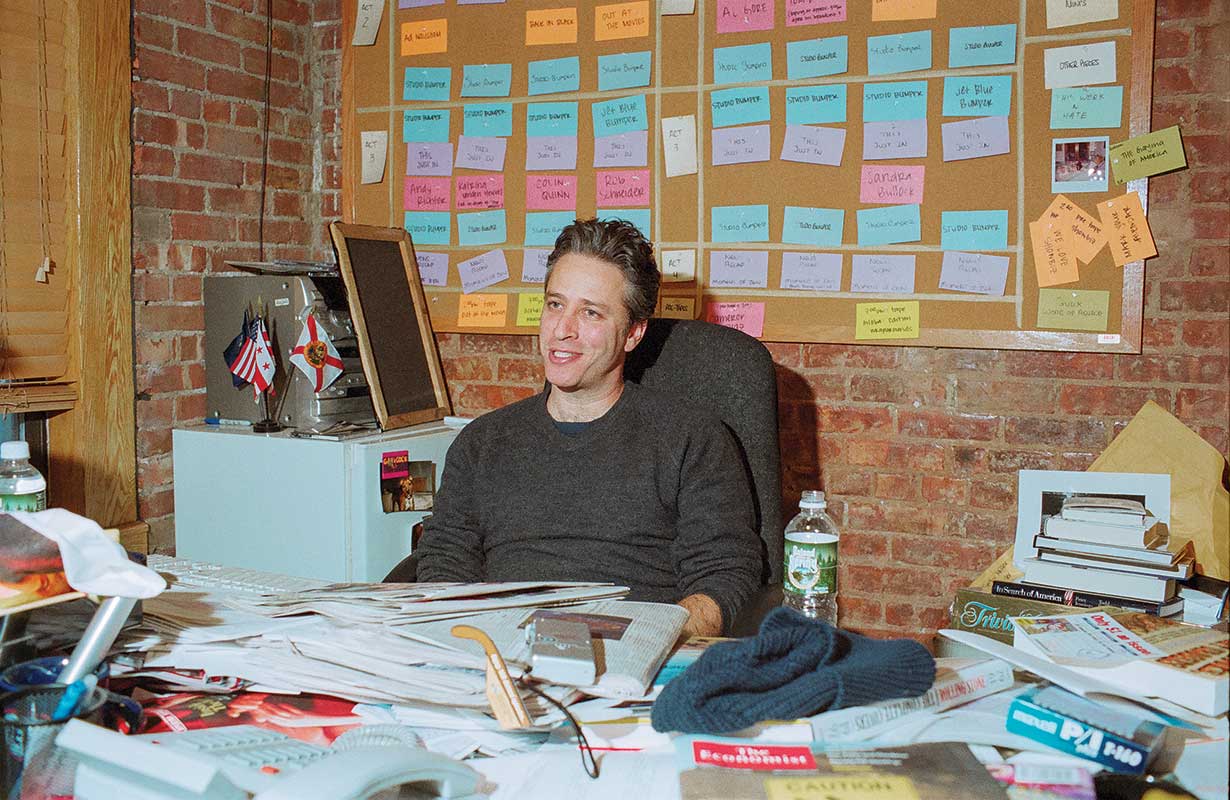
In 1995, when former MTV news director Doug Herzog took over as comedy Central’s president, the channel was a premium-cable oddity. Born of a merger between Time Warner’s Comedy Channel and Viacom’s rival channel, Ha!, Comedy Central was best known in those days for Candid Camera reruns, British and Canadian comedy imports like Absolutely Fabulous and The Kids in the Hall, and a smattering of original programming. “Of course, we had Bill Maher,” Herzog says, referring to the host of Politically Incorrect. “Maher was the first guy to do politics every night. I gotta give him credit for that. We could debate on how well he was doing it. But he was doing it.”
Up through the Bill Clinton era, TV political comedy rarely rose above the level of harmless barbs. Late-night hosts like David Letterman and Jay Leno would crack wise about the president’s sexual appetites or Monica Lewinsky’s waistline. But they were historically coy with their politics, in the interest of not alienating their audience. (Though it should be said that in the 1980s, Johnny Carson made so many jokes about Ronald Reagan dyeing his hair that the president’s wife personally asked him to stop.) That was all about to change.
By the mid-’90s, the very format of news had opened up considerably. Where one might have previously regarded “the news” as a daily digest of events (local, national, global) that an editorial board deemed, well, newsworthy, the cable news medium turned news-gathering—and editorializing—into a form of entertainment. In 1996, Rogers Ailes, who was famous for his work as a PR mastermind on the presidential campaigns of Richard Nixon, Ronald Reagan, and George H.W. Bush, left the NBC-owned cable news channel America’s Talking to become CEO of Fox News. The so-called “balance” invoked by the network’s original slogan soon tipped when Fox became a 24/7 clearinghouse for anything and everything related to the Clinton-Lewinsky scandal. Fox further baited hyper-partisan audiences with programs like Hannity & Colmes, a mock debate show between a liberal and a conservative that had all the competitiveness of a ballgame between the Harlem Globetrotters and the Washington Generals, and The O’Reilly Factor, which had become America’s most-watched cable news program by 2001. In an age when nightly news anchors were seriously discussing whether oral sex is sex, it wasn’t just that politics had gotten silly—it was that the news media risked coming across as increasingly disengaged, and ideologically partisan.
When Maher began plotting a move—he’d take Politically Incorrect to ABC in 1997—Herzog foresaw a gaping hole in the programming schedule. Keen to explore the mix of comedy, news, and commentary that marked Maher’s early, pre-smoking-weed-in-a-leopard-print-club-chair output, Herzog tasked two producers, Madeleine Smithberg and Lizz Winstead, with developing a replacement. The pair tapped SportsCenter anchor Craig Kilborn as host of The Daily Show. Other early contributors had experience producing mainstream news pieces and were eager to lampoon them. “We were all sort of disgusted at how news had become a form of entertainment,” says Brian Unger, a veteran of CBS News and one of The Daily Show’s original correspondents. “We were always focused on how stories were being told, and we wanted to satirize that storytelling.”
In those days, the program’s focus was on pop culture, with celebrity interviews, filmed segments featuring a cast of correspondents interviewing American oddballs (eccentrics obsessed with the South Florida cryptid known as Skunk Ape, a barber who collects his customer’s hair, etc.), and the occasional topical zinger aimed at Lewinsky or Linda Tripp. The humor captured a prevailing Gen X attitude: snarky, above-it-all, a little mean-spirited.
By 1998, Comedy Central was mulling the idea of a new host. Jon Stewart wasn’t exactly top of mind. “I actually didn’t think Jon would be interested,” Herzog says. The comedian had a solid CV as both a comic actor and a late-night fixture, regularly serving as guest host on CBS’s The Late Late Show With Tom Snyder and having previously hosted The Jon Stewart Show on MTV, where Smithberg and Winstead had been producers. There were even rumblings that he was in line to take over Letterman’s Late Night, and Herzog worried that the gig was beneath a rapidly rising star. But Stewart surprised him. “He clearly saw something in that show, in that platform, in that format, for himself,” Herzog says.
Longtime Daily Show correspondent Stephen Colbert noticed a distinct shift under Stewart’s leadership and embraced it. “When Craig was there, it wasn’t so political,” he told NPR’s Terry Gross in 2005. “Jon has asked us to be political, and to share his interest in doing political comedy that actually has some thought behind it.” Shortly after Stewart’s premiere as anchor of The Daily Show, on January 11, 1999, it was clear that the show had grown up a bit. The focus on pop culture receded as news and politics rose to the surface.
Not everyone was convinced. Herzog worried that politics felt “like homework.” He left the network shortly after Stewart made his debut, for what would prove to be a short-lived stint at Fox. “I was wrong,” Herzog admits. “He was right. And he remains right. Politics is culture.”

Stewart’s arrival at the Daily Show desk dovetailed auspiciously with the run-up to the 2000 election. The new team leaned in with the “Indecision 2000” segments, but it wasn’t the first time the network had adopted the clever rubric. In 1992, when Comedy Central was still finding its legs, Al Franken filed a series of “InDecision” pieces from the Republican and Democratic conventions, joined by everyone from future View host Joy Behar to venerable Hollywood screenwriter Buck Henry to libertarian illusionist Penn Jillette. But The Daily Show really seized on the idea as a way of exploring the program’s new direction.
A series of political spot reports featured field reporters dressed in comically enormous jackets emblazoned with The Daily Show’s logo. Monologist Lewis Black weighed in on the unfolding election with his trademark breathless, on-the-verge-of-a-heart-attack gusto. Back in New York, Stewart served as ringleader of the whole political carnival, framing these dispatches and other news of the day with the mix of wit, smarm, and seen-it-all disbelief that would become his—and the show’s—stock-in-trade.
Among the most notable “Indecision 2000” segments was correspondent Steve Carell’s voyage on Republican candidate John McCain’s campaign tour. The so-called “Straight Talk Express” trundled from VFW halls to old folks’ homes, spreading its gospel of tax reform, renewed public service, and other common-sense-isms. And Carell and a team of Daily Show producers tagged along. (Technically, they tailed behind in an “overflow bus.”)
In a sit-down interview, Carell lobbed a series of softball questions at McCain before veering down a considerably more serious avenue. “Senator,” Carell asked, “how do you reconcile the fact that you are one of the most vocal critics of pork barrel politics and yet, while you were chairman of the Commerce Committee, that committee set a record for unauthorized appropriations?” McCain sat there, dumbstruck. After an uncomfortable pause, Carell broke the tension with a laugh. “I’m just kidding. I don’t even know what that means!”
“We went over it for two hours,” remembers Nick McKinney, a former Daily Show staffer who produced the interview. “Just rehearsing that beat. Exactly how long it should go.” That moment captured something that defined the show’s new direction. Now bigwigs could be lulled, then left-hooked, when a fake newsman suddenly stiffened into a serious posture. Then a declaration of “I’m just kidding!” would provide the back-footed pol with what McKinney calls “an out.”
Unger, the show’s original correspondent, says that this sort of maneuver offers “a perfect escape hatch” to both the interviewee and the interviewer: The comedian gets to gesture toward seriousness while simultaneously avoiding being taken too seriously. “When the going gets tough and gets too hot in the kitchen,” Unger says, “you can always step out the back door and say, ‘Hey, I’m just a clown. You guys are the real serious people.’”
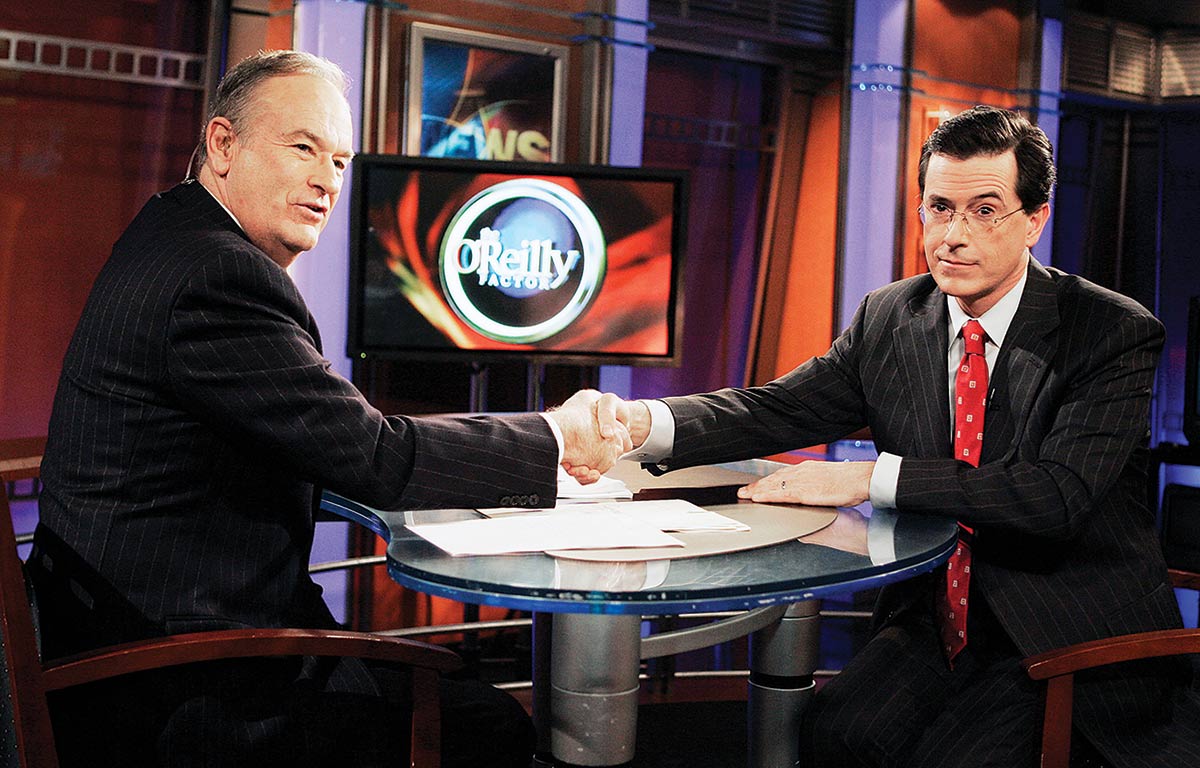
On the evening of December 12, 2000, some 35 long days after Americans shuffled off to the polling stations, the 54th presidential election in the United States was finally settled. In The Daily Show’s studios in the Hell’s Kitchen neighborhood of Manhattan, Stewart broke the news to an anxious, irritable America. “It’s now official. We can call it, at—” he paused, to check an invisible watch on his wrist, “855 hours and two minutes into this election night. The state of Florida and its 25 electoral votes, with 100 percent of its precincts reporting, will go… to George W. Bush.”
Watching it in 2024, what’s most remarkable about the broadcast is the audience reaction. When Stewart called the race for Bush, he was met with a smattering of applause and boos that felt more or less equal. A quarter-century later, the very idea that Bush voters, or Republicans of any kind, would be found among the live audience of The Daily Show seems faintly ridiculous. Were they plants, plied with cash in hand for creating a sense of balance? Did they get lost en route to a taping of Hannity & Colmes? Or a boat show?
Popular
“swipe left below to view more authors”Swipe →That lack of alignment wouldn’t last long. Back in the primaries, Carell’s question to McCain had garnered headlines in the straight news media, suggesting a tactic that Stewart himself would become adept at exploiting. The success of “Indecision” later led to his appearances as a talking head on the sorts of self-serious news magazine shows The Daily Show positioned itself against. At the peak of his fame, he was invited on CNN’s popular left-versus-right debate show Crossfire, ostensibly to promote a book. Instead, he began sparring with the hosts, Tucker Carlson and Paul Begala, deriding them as “partisan hacks” and declaring that their show was “hurting America.” He compared the format to pro wrestling: ginned-up political theater. When Carlson accused the Daily Show host of serving as Democratic presidential nominee John Kerry’s “butt boy,” Stewart flipped the accusation around. “I didn’t realize that news organizations looked to Comedy Central for their cues on integrity,” the comedian clapped back. “You’re on CNN! The show that leads into me is puppets making crank phone calls!”
Within a few months, CNN had canceled Crossfire and canned Carlson. Stewart was crossing—or muddling—the line between comedian and commentator. He was freely engaging in rank political and media punditry, while insisting that his role as a satirist insulated him from criticism—a line he has since walked uneasily. As McKinney quips, “You can’t make a career out of saying the emperor has no clothes and then shop at the same tailor.”
The Bush years would cement The Daily Show’s pride of place in the liberal-media ecosystem. By the spring of 2001, the “Indecision” broadcasts had earned Stewart and his team a prestigious Peabody Award. The official citation proclaimed that the “inspired, irreverent, satirical pieces follow in the tradition of political pundits through the ages.” With typical affected weariness, Stewart accepted the trophy in front of assembled members of the real-news media. “You think it’s hard to be a news organization?” he cracked. “Try faking it.”
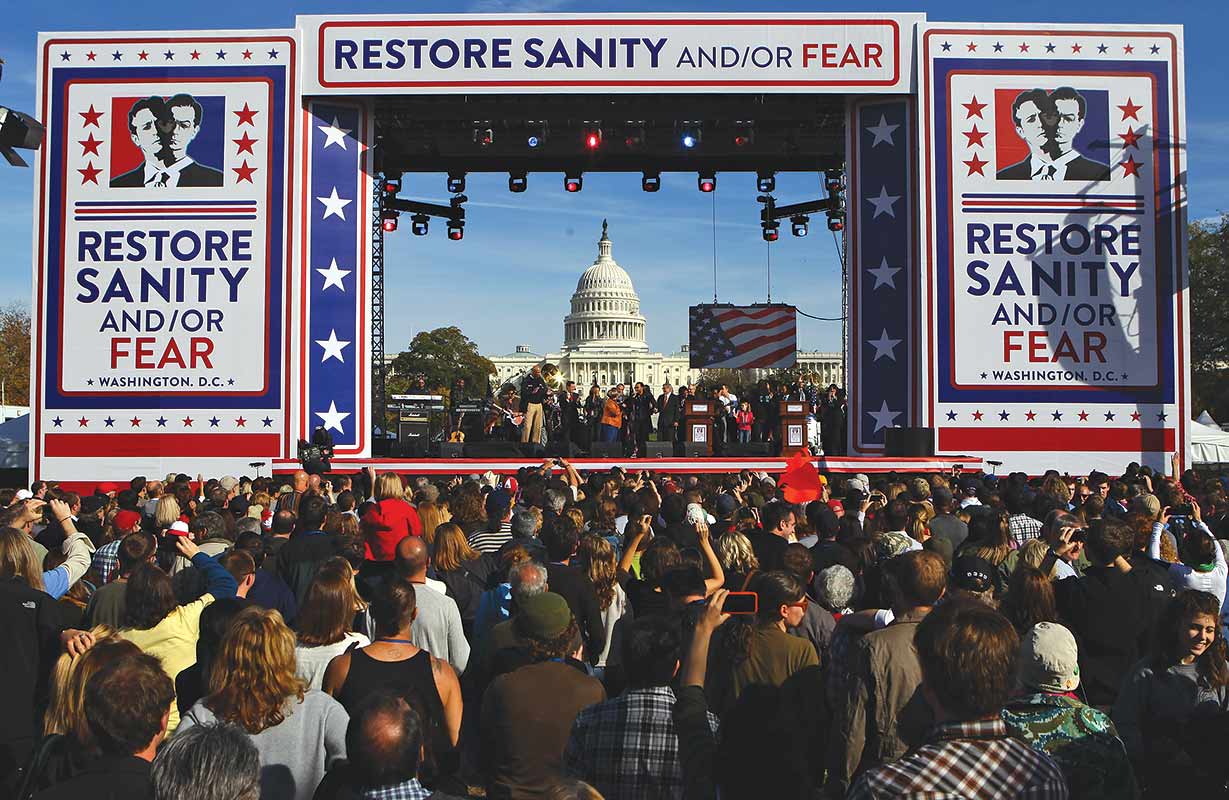
Two thousand and one turned out to be a long year, and the events of September 11 made it extremely difficult to be funny. Saturday Night Live’s 27th season opened with producer Lorne Michaels asking New York City Mayor Rudy Giuliani, flanked by first responders, “Can we be funny now?” At Comedy Central, The Daily Show downshifted a bit. The network, producers, writers, and stars mulled the problem of how to do satire in a time that had become, in an instant, so deadly serious. The show adopted an incongruously earnest tone; Stewart wept, openly, on the air. It was, perhaps, moving. But it was not very funny. Then they were given a gift: a white, powdery, bacterial blessing.
“If you were watching the news at that time,” Madeleine Smithberg recalls, “you would have thought anthrax was raining down on everyone.” By mid-September, stories emerged about US politicians receiving letters scrawled with jihadist slogans and laced with the potentially lethal bacteria. Twenty-two people were poisoned. Five died. The FBI expended record resources investigating the source of the letters, eventually attributing them to a US Army microbiologist named Bruce Ivins. The news media was sent into hysterics, further stoking the fires of collective dread and agitation. And with that, Smithberg remembers, “we were back.”
If making fun of news items still seemed a bit gauche in the weeks after 9/11, making fun of news broadcasts was fair game. The Daily Show’s coverage of anthrax—and later, of the deepening US military quagmires in Iraq and Afghanistan—harked back to the program’s original, Kilborn-era remit: mocking the histrionics of daily news broadcasts and weekly news magazine programming. But where that show found targets across the political spectrum, the post-9/11 Daily Show was distinctly defining itself against the right-wing theatrics of George W. Bush and Dick Cheney, as well as their eager water carriers at Fox News. “They were super-serving their base,” Unger says of the partisan drift during the Stewart years. “I somewhat lament that.”
“There was no meeting where we decided, ‘We’re doubling down and moving to the left,’” Smithberg says. “It was more a response to what was happening in the news and in the world. It was a call to arms that we responded to…. We had a really strong sense of right and wrong, and good and evil.”
Cable news was taking notes. Eschewing the pretense of objectivity that was once obligatory in newsrooms—or at least in J-school seminars—a new class of liberal pundit emerged, to tilt at the rising axis of neoconservative Republicans, Christian nationalists, and, especially, Fox News. When Stewart accepted his Peabody for the “Indecision 2000” broadcasts, he joked onstage that Fox was The Daily Show’s only competition.
It wasn’t long before other challengers emerged. After Ailes’s departure in 1996, America’s Talking renamed itself MSNBC and carved out a lucrative niche for itself in the Bush years with its slanted criticism of the forces of the American right. In 2003, Keith Olbermann (another SportsCenter alum) launched his evening punditry program, Countdown With Keith Olbermann. The network would unveil Morning Joe with Joe Scarborough in 2007 (it later became President Biden’s favorite way to start the day) and steal Rachel Maddow away from Air America for her own prime-time-slotted program, premiering in 2008. (Maddow has acknowledged her debt to Stewart, claiming that The Daily Show made the news media “sharper and more self-conscious and ultimately better.”)
Meanwhile, The Daily Show drew on the success of the “Indecision” model, with branded segments like “Mess O’Potomia,” “The Futile Crescent,” and “Guantanamo Baywatch” satirizing America’s Middle East adventurism. The “Indecision” format would be revived for the 2004 and 2008 presidential races, and the name was reworked in various forms to cover other global elections: “A Spot of Indecision 2005” covered the UK parliamentary vote; the bilingual “Indecision/Indécision 2006” focused on the Canadian general election.
Interview subjects matured too. “The show made a name for itself,” head writer Ben Karlin has said, “as a place where politicians and journalists would come to talk.” The usual roster of actors and musicians decreased, as the show booked an increasing number of journalists (Brian Williams, Fareed Zakaria, Bill O’Reilly), along with politicians from Bob Dole to Joe Lieberman—even the original “Indecision” foil, John McCain. By 2003, the show that formerly spotlighted Scream star Matthew Lillard and Spice Girl Mel C. was hosting Senator Hillary Clinton and the former supreme allied commander of NATO, Gen. Wesley Clark.
“The show became smarter,” says correspondent Mo Rocca. “Its purpose and its message became clearer. It was hard to pull that off and keep it funny. But the ratings kept growing. So I guess that’s proof that it was working…. I can only speak for myself, but I started to miss the loopiness of the earlier show.”

This embrace of all things political trickled out of The Daily Show’s studios and across Comedy Central’s wider slate. South Park skewered sensitive political subjects with an equal-opportunity-offender anarchism, while somehow still drawing a conclusion that left the status quo intact. Daily Show ranter-in-chief Lewis Black received his own spin-off, and the popular late-night-talk-show format would itself spawn a hive of Comedy Central programming: The Graham Norton Effect, The Showbiz Show With David Spade, Weekends at the DL.
Doug Herzog insists that there was no internal memo telling everyone at Comedy Central to get political. But after seeing the success of The Daily Show, he started to realize that embracing material ripped from the headlines could make the network itself headline-worthy. It was less about an explicit politics and more about embracing the way the public engaged with media in the era of the 24-hour news cycle. “It was very newsworthy,” he says. “You can get a lot of attention. And we did.”
Beginning in 2002, The Daily Show With Jon Stewart was immediately followed by Tough Crowd With Colin Quinn, a roundtable-discussion show led by the former SNL “Weekend Update” host. NYC comedy stalwarts like Judy Gold, Patrice O’Neal, and Greg Giraldo would hash out the issues of the day. Under Quinn’s stewardship, many of these unvarnished conversations revealed a discernible conservative slant. In one heated exchange, Quinn defended America’s right to invade Afghanistan and Iraq in response to the 9/11 attacks. Challenged by comedians Scott Thompson and Maria Bamford, the host flew off the handle: “Once the World Trade Center went down, I don’t want to hear about the root cause!” Here was an SNL alum aggressively advocating for his belief that American interventionism needed no justification, on a network that only a decade earlier was broadcasting reruns of Whose Line Is It Anyway?
The cancellation of Tough Crowd in 2004 left the coveted post–Daily Show slot wide open. Herzog, who returned to Comedy Central in 2004, originally planned to fill it with Too Late, a talk show hosted by comedian Adam Carolla. “Back then he was seen as more of a blue-collar guy than as a conservative,” Herzog says. “Adam did a six-week run. It was, with all due respect, awful.” So instead of programming some red-state counterpart to Stewart, Comedy Central slotted in a highly sophisticated parody of the right-wing media. “We put Colbert on and never looked back.”
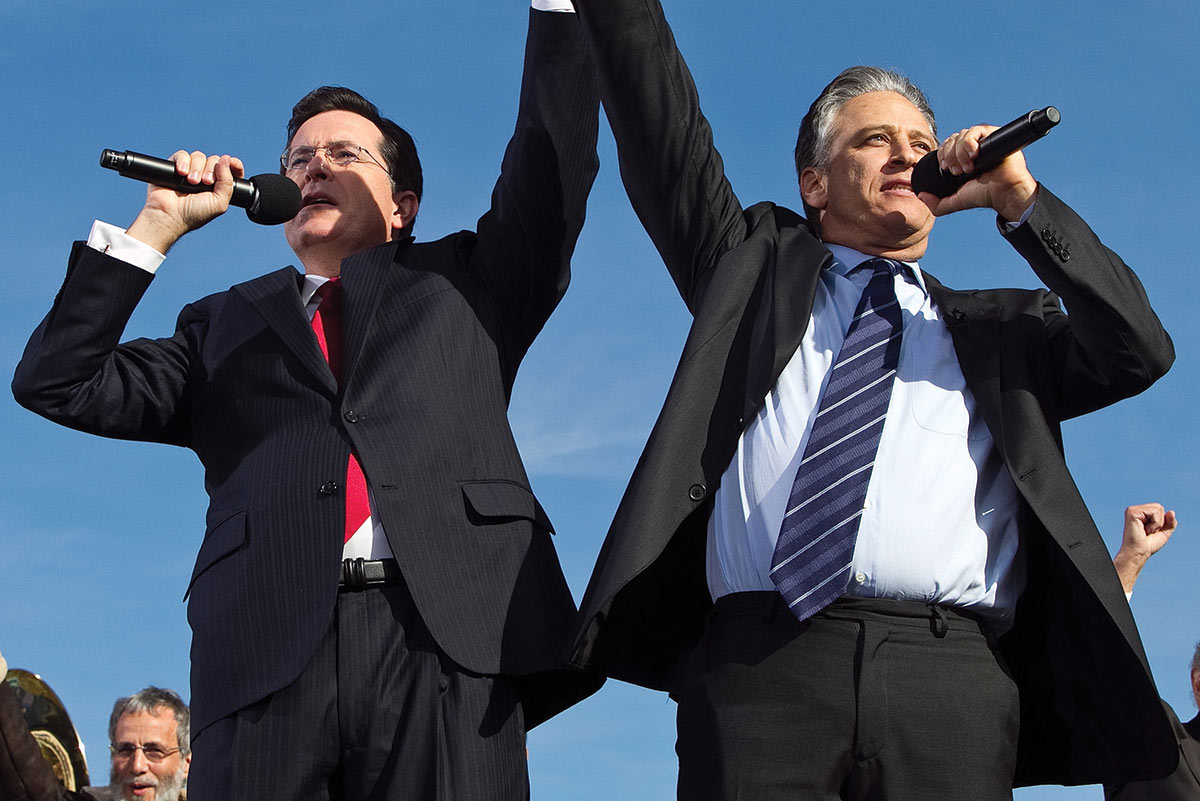
Premiering in the fall of 2005, The Colbert Report (often given an affected French pronunciation, like “rapport”) amounted to an extended parody of the right-wing-media ecosystem. Building on his straight-talking, no-nonsense Daily Show correspondent character, Stephen Colbert starred as a super-patriotic, low-information blowhard. Like Bill O’Reilly—but intentionally funny.
The set was a Fourth of July BBQ of red, white, and blue, decked out with American flags, a framed replica of the Constitution, and a Captain America shield. In a not-so-sly nod to American conservatism’s increasingly fascist bent, it was dubbed “The Eagle’s Nest,” like Hitler’s Obersalzberg retreat. A recurring bit called “The Blitzkrieg on Grinchitude” sent up Fox News coverage of the “War on Christmas” by celebrating the victories of pro-yule culture warriors.
Another popular segment was “The Wørd,” a riff on The O’Reilly Factor’s “Talking Points Memo,” using bullet points to offer ironic counterpoint to a windbag monologue. One of these segments introduced the concept of “truthiness,” defined as a form of intuition that denied (or transcended) the boring rigors of evidence and logic, and which (in Colbert’s reckoning) explained President Bush’s decision-making and his appeal. The term quickly slid into the general lexicon, anticipating the current climate of “fake news” and so-called “post-truth politics,” in which partisan polarization arms different segments of the electorate not only with diverging opinions but diverging sets of facts.
Boosted by its post-Stewart time slot, the spin-off was a hit straight out of the gate. Within two weeks, The Colbert Report was retaining 86 percent of The Daily Show’s lead-in viewership. By then, during Bush’s second term, Herzog had learned not to misunderestimate Stewart’s approach. If The Daily Show was guilty of super-serving its base, Herzog seemed happy to offer heaping second helpings. “If you go back and watch the first night of Colbert, that show came out of the oven completely baked,” Herzog says. “All of a sudden we had what I called the ‘Daily Show Network,’ which was a network within a network.”
If Stewart was settling into an extended sinecure as the voice of Gen X (and millennial) exhaustion, Colbert, in character as “Stephen Colbert,” seemed more keen to exploit his jester’s privilege. In 2006, he hosted the annual White House Correspondents’ Dinner—in character. The event had become something of a tradition in Washington: a fun, nonconfrontational venue for the most powerful people to be gently ribbed in front of their peers. More of a light simmer than a roast.
Colbert turned the heat up. He mocked Bush’s intelligence and proud anti-intellectual posture (“Guys like us, we’re not some brainiacs on the nerd patrol”), the disastrous invasion of Iraq, the spying scandals, and Bush’s cynical photo ops following 9/11 and Hurricane Katrina, and generally savaged his administration’s incompetence—all while appearing to praise it.
The room was strangely silent. Some Bush lackeys headed for the exits. The president himself was not particularly amused. “You could hear a fucking pin drop,” recalls Herzog, who was there. “My takeaway at the time was that George W. Bush may be a big, stupid jerk, but he’s our big, stupid jerk…. It was wildly uncomfortable to be in that room. But it’s one of the great moments in political-comedy history.” Back on his own show, Colbert claimed that the lack of laughter and applause in the room that night was actually a show of “very respectful silence.”
For those, like myself, whose experience of post-9/11 life amounted to endless frustration with both a corrosive presidential administration and a putatively adversarial media, Colbert’s remarks had a genuinely bracing quality. It’s a cliché that comedians are valuable because “they say what we’re all thinking.” But that’s exactly what happened here: Colbert said what we were all thinking—and to the president’s face, as he sat in the ballroom of the Washington Hilton, surrounded by his friends and enablers. Colbert was speaking truth—not just “truthiness”—to power.

In 2008, Comedy Central’s “Daily Show Network” faced another existential threat. If Bush was a boon to political satirists, Barack Obama’s promise of all-caps “HOPE” presented a more substantial dilemma. Challenging Obama directly risked alienating the programs’ liberal audience; ignoring him would make these anti-institutional nightly news comedy shows seem institutionally captured. Instead of pivoting from right-punching to left hooks, both programs responded by recommitting to kicking against the conservative pricks. Media and punditry would once again emerge as the key targets.
That detachment from the halls of power led to one of the strangest political (or apolitical) events of the era: 2010’s “Rally to Restore Sanity and/or Fear.” On a crisp autumn day, Stewart and Colbert assembled tens of thousands of fans at Washington, DC’s National Mall for a bizarre non-rally rally meant to call attention to the widening partisan divide. For Stewart, it was an attempt to parlay The Daily Show’s “false authority” into a live event. Some producers warned against the idea, but Comedy Central’s banner stars could not be reasoned with. Carafe Minassian, a political PR strategist who worked behind the scenes on various Clinton candidacies, helped secure the required permits.
I was among the throng gathered that day—shipped down on a bus from Canada to report on the goings-on for a now-defunct local blog. Ostensibly a prolonged, live-action-role-play parody of events like Glenn Beck’s 2010 “Restoring Honor” rally at the Lincoln Memorial, it was an occasion for moderates, centrists, and ironists tired of extremes to congregate and demand… what, exactly?
A performance of Yusuf Islam’s “Peace Train” was followed by Ozzy Osbourne’s “Crazy Train.” Then Colbert and Stewart duetted with the O’Jays on their 1972 anthem “Love Train.” Stewart delivered a “Moment of Sincerity” monologue, pleading for more “reasonable compromises.” Puttering around the grounds, speaking to attendees, and feverishly transcribing the mock protest placards (“INCITE CIVILITY & REASON”; “I ♥ BOOBS”; “I AM HOLDING A SIGN”; etc.), I recall feeling an ache of disillusionment. Here were tens of thousands of people treating comedians like rock stars, only to be subjected to an extended lecture on the merits of centrism.
Stewart compared The Daily Show to a Mexican restaurant, reworking the same basic ingredients into a range of menu items. The analogy is uncharitable to the complexities of Mexican cuisine, but his point tracks, in a way. For all its pretenses to importance (or at least self-importance), the “Rally to Restore Sanity and/or Fear” failed to concoct anything new out of those ingredients. Its masters of ceremonies would likely play the battered “It’s just comedy!” card—except it wasn’t especially funny. Squint, and this parody of hollow demagoguery could be confused for the thing itself.
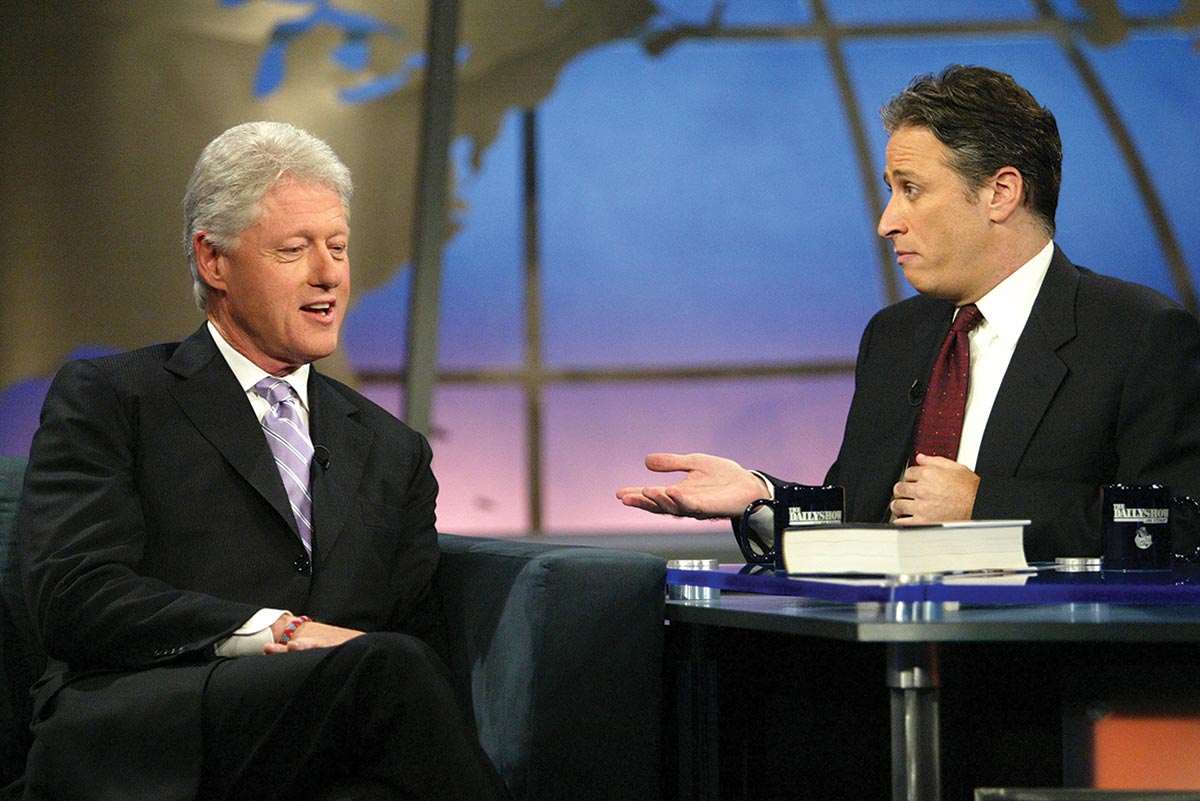
On August 6, 2015, Comedy Central aired the final episode of The Daily Show With Jon Stewart. John Kerry, Bill O’Reilly, Hillary Clinton, and, of course, John McCain all filmed heartfelt farewells to the man who spent more than 15 years mocking them on television—while also helping soften their public image. Trevor Noah took the reins as the new host, and the show’s ratings fell by 37 percent. The drop was attributable to the general decline in cable news programming, to the dwindling cultural influence of the late-night-talk-show format, and to Noah’s fatal flaw of not being Jon Stewart.
The Daily Show’s waning relevance can be a bit deceptive. Sure, the show itself declined in popularity and influence. But at the same time, its popularity and influence had reengineered the landscapes of American political comedy and broadcasting. Unlike his predecessors in the American late-night lineage, Stewart wasn’t just giving his audience water-cooler quips; he was, in a real way, training them in what was important and what wasn’t. He was instructing them in what to care about.
The worldview that The Daily Show wrought predominates in today’s media. Of the four major-network late-night talk shows, two—The Late Show With Stephen Colbert and Jimmy Kimmel Live!—are hosted by Comedy Central vets. The other two—The Tonight Show Starring Jimmy Fallon and Late Night With Seth Meyers—fall to seasoned fake newsmen who matriculated from Saturday Night Live’s “Weekend Update” desk. In 2021, Fox News got in on the late-night action with its own conservative comedy panel show, Gutfeld!—a modern-day Tough Crowd stocked with even lower-rent comics.
But after Stewart’s departure from the national stage, the mainstream media entered new territory—namely, the Internet. In 2017, a trio of former Obama staffers founded Crooked Media, a podcasting empire with a pervading tone that could be described as “nominally humorous”—epitomized by its flagship program, Pod Save America, hosted by the founders and a fourth Obama administration alum. The company pulls double duty, driving get-out-the-vote efforts and advocating for liberal causes. Indeed, it’s easy to regard Crooked Media as little more than an infotainment wing of the Democratic Party. Farther left, the 2016 Bernie Sanders candidacy energized a new ecosystem of wry, often caustic progressive political commentary, which has the distinction of being legitimately funny—perhaps plugging the hole that the “Daily Show Network” never figured out how to fill during the Obama years.
“It would be hard to overstate how influential The Daily Show was on how I understood the world,” says Will Menaker, a cocreator and cohost of the popular political-comedy podcast Chapo Trap House. Chapo’s satire tends to jab at the center, targeting the sort of institutional liberals who used to sleep soundly after their nightly double feature of Stewart and Colbert. “I don’t think they were used to being made the object of a joke,” says Menaker of his show’s liberal critics. “Because of The Daily Show, they assumed that all media and comedy was hegemonically liberal. And for good reason! They always knew that they would be the ones laughing at the hypocritical, foolish right wing.”
Growing up in Turkey, Hasan Piker, a 33-year-old Twitch streamer who’s one of Rolling Stone’s “25 Most Influential Creators of 2024,” watched The Daily Show to get a bead on what was happening in American politics. “My dream when I was younger was to be Jon Stewart,” Piker says. Now his “primary goal” is to expose his millions of viewers to his political perspective: leftist, anti-imperialist, critical of Republican conservatism as well as institutional liberalism. “I want them to hear a perspective they’re completely oblivious to,” he says.
Lefty pundit-entertainers also inherit from The Daily Show a sense of deep, granular specificity. An episode of Chapo may mock marginal-seeming figures like Trump’s former “deputy assistant” Sebastian Gorka or Catholic conservative columnist weirdo Rod Dreher. Taking a page from The Colbert Report, Piker will sometimes role-play as “Hank Pecker,” a right-wing “red-blooded patriot American” and closeted gay homophobe. This isn’t political comedy for people who skim the headlines; it’s geared more toward those with multiple Substack subscriptions and hyperactive social media presences, for whom “the news” is a kind of oxygen. But as much as they offer an alternative to the more traditional, barely-left-of-center tilt of American political comedy, there’s little doubt that this liberal satirical hegemony still prevails.
Meanwhile, the “Daily Show Network” that Herzog conceived when he launched The Colbert Report has itself expanded. Many of the show’s correspondents have gone on to spread the good (or at least wry but impassioned) word, on Comedy Central and elsewhere, like apostles founding their own churches. Larry Wilmore, Samantha Bee, Michelle Wolfe, Hasan Minhaj, Jordan Klepper, and John Oliver have all parlayed their Daily Show experience into their own comedic talk shows, with varying degrees of success. Other correspondents, like Unger and Rocca, moved from The Daily Show into something closer to straight news, finding homes at NPR, MSNBC, and CBS. “My time at The Daily Show inoculated me from behaviors I might fall into as a network correspondent that would just be shameful,” Rocca says. “If I ever behave the way I would have in a satirical interview, I catch myself and say, ‘Don’t become the thing you used to make fun of.’”
To some, it’s a lesson Stewart might have heeded. Post–Daily Show, he would remain a darling of institutional liberalism and the self-identifying spokesman for “the distracted center.” He’d also become a frequent target of the new generation of progressives raised on Comedy Central. In 2014, Stewart directed his first feature film, Rosewater, based on the true story of the journalist, human rights activist, and former Daily Show guest Maziar Bahari, who was detained for 118 days in an Iranian prison. Stewart followed that with 2020’s Irresistible, a farce about a cunning Democratic consultant (Steve Carell) who attempts to shift the political landscape of a right-leaning rural Wisconsin town. The fixer’s scheme to convince a retired Marine (Chris Cooper) to run for office as a Democrat is challenged when he learns—to his, and the audience’s, considerable shock—that simple country folk are neither as pliable nor as conservative as he had hoped.
“That movie kept the left-wing podcast industry in business for two months after Bernie suspended his campaign,” jokes Will Sloan, a cohost of the pop-and-politics podcast Michael and Us. “Of course, Stewart’s idea is that, at the end of the day, all of us share the same common values, and that there are things called ‘the political machine’ and ‘the media’ that come in to rile us up.” In a review for Jacobin, Sloan’s podcast cohost, Luke Savage, decried Irresistible as evidence of a naïve “why-can’t-we-all-just-get-alongism” that has increasingly defined Stewart’s centrist turn.
Of course, the issue is not the endorsement of “getting along,” which is laudable enough on its face. The issue—which Sloan calls “a core Jon Stewart theory”—is the implication that political differences have no material basis, that they are manufactured by the media to juice ratings. Expose the media-induced hysteria of one or another culture-war skirmish, and political differences will somehow simply disappear. But as the past decade or so of American life has made obvious, political conflicts are very real, and they’re unlikely to be resolved with well-meaning pleas for the restoration of sanity. The very premise of a funnyman issuing such calls, with apparent authority, is by now a feature of our popular culture that is taken for granted.
The inverse is also true: The success of The Daily Show and Comedy Central’s broader slate of post-Bush political programming changed the mainstream news media itself. “The Daily Show’s biggest impact on institutional journalism is that you started seeing people in mainstream hard news trying to be funny,” Unger says. “Brian Williams started being kind of satirical in the way he spoke to his audience on the nightly news. I think there was a gradual migration toward pointing out absurdity in politics and in culture. As The Daily Show became more of a news source, mainstream news became less hard news. We saw this convergence between these two places, where anchors and reporters could ad-lib these glib, sarcastic remarks. The two worlds now overlap.”
The ravages of time were cleverly made a feature of Stewart’s first episode back at his old post, on February 12, 2024. The Problem With Jon Stewart, a short-lived Apple TV+ series that ran from 2021 to 2023, had presented its host dressed down in dad jeans and a bomber jacket. Reinstalled in The Daily Show’s old Hell’s Kitchen digs, Stewart was once again sharply clad as a TV newsman, his once-salt-and-pepper hair now fully gray. In his opening monologue, Stewart mocked his own aging, comparing it to that of the elderly presidential front-runners. There were jabs at his own lofty ambitions as host of The Daily Show: “Did you save democracy yet?” asked correspondent Jordan Klepper. As backward-looking as it may have been, Stewart’s return was nonetheless welcome. He was funny and smart in the way that he had always been funny and smart. There were the clips, the occasional censored expletives, the wide-eyed, pregnant pauses meant to communicate a common bafflement. But there was a renewed verve, too, that cut against Stewart’s status as an éminence grise of the liberal-media elite.
After President Biden’s disastrous debate performance against Trump, and the attempts by Democratic operatives to cover for it with unconvincing spin about the commander in chief merely having a cold, Stewart went all in, going live in the immediate aftermath. He mocked Fox News and CNN, naturally. But he also trained his sights on Biden himself, comparing the president to a scarecrow with “resting 25th Amendment face.” In a later episode, he described Biden’s performance as “a shocking display of cognitive difficulty” and referred to the “omertà” around the Democrats’ response to it. Liberals didn’t take kindly to the criticism. Keith Olbermann called Stewart a “bothsidesist fraud.” Mary Trump, the 45th president’s niece and one of his most vocal critics, called Stewart a “danger to democracy.” For good measure, she characterized the 2010 “Rally to Restore Sanity and/or Fear” as a “joke which inspired an entire generation to shrug off politics and ignore the dangers of the right wing.” The Daily Show’s base, it seemed, was no longer being super-served.
But in an unlikely turn, Stewart 2.0 has won kudos from some progressive doubters who have been buoyed by his return. “It has been heartening,” Menaker says, “to see him come back and immediately draw the ire of the Joe Biden vanguard of Democratic Party hacks and liberals who are like, ‘How dare he! How dare he attack our president!’ They’re talking like the Bush administration!”
Perhaps Stewart, in his dotage, has reconsidered the value of centrist-pleasing get-alongism. Or maybe it’s just another “reasonable compromise”—an attempt to prove that he still has bite. Whatever the case, the videos amassed tens of millions of views online, suggesting that Stewart’s voice still resonated with a broad audience of pundits, cynics, and potheads zoned out in front of late-night cable—or YouTube. When calls for Biden’s resignation grew louder and the president eventually stepped aside, Stewart’s barbs were, once again, redeemed as prescient.
Stewart’s criticism of cable news theatrics always betrayed a certain nostalgia for the bygone days of the trustworthy, nonpartisan, comforting presence of the TV newsman, whose very visage could offer consolation. A quarter-century after the epochal “Indecision” broadcasts, having spawned a whole culture of spin-offs and rip-offs that refined the tone of American political satire, and having arguably remade US political life in his own image, Stewart has become something other than a generational Groucho Marx, or George Carlin, or Eric Cartman. He has become the Walter Cronkite of the “fake news” era. His mugging, his face-pulling, and his continued capacity to surprise his skeptics provides its own kind of solace—for better or for worse.
As the divisions that Stewart has satirized throughout his career deepen, and as trust in the mainstream media nosedives to an all-time low, perhaps it’s true that America’s political center cannot hold. In the meantime, maybe it can still be distracted.


